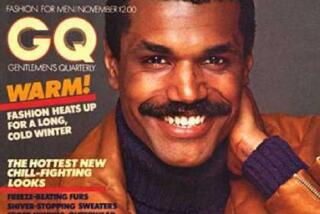The Rippled Effect
- Share via
Farewell, delicate Twiglet boy models who seem to have dominated the international runways the last few years. Here comes a 21st century update: a more athletic aesthetic of the ideal male who cares about looking fashionably right in lean low-rise trousers and snug sleeveless shirts.
Think hunky, but not balloon-shaped crusher from the World Wrestling Federation, either. Bodybuilder Lite, if you will--a cut body as portrayed on television, in movies, men’s magazines and in fashion ads for the upcoming spring and summer.
“Models were pumped up big time in the 1980s,” says David Wolfe, creative director of the Doneger Group, a New York fashion consulting firm. “Then they went out of style and in came the skinny, undernourished, druggie guys that designers thought were hip and cool.”
Now comes the latest and more erotic physique: Cruise down the Sunset Strip, between Crescent Heights Boulevard and Sweetzer Avenue, and look skyward. Up there on a billboard is Calvin Klein’s new underwear model, Travis Fimmel, packed into low-waist briefs, showing off a hard body of impeccable pectorals and abs that look like an ice cube tray.
The Australian cattle ranch boy credits his incredible body to surfing, skiing and football. “I’ve never worked out, mate,” says Fimmel, who modeled briefly in Melbourne and Sydney. “It doesn’t interest me.” He is, after all, 22 and free spirited--arriving at LAX last May with no job and only $60 of which he spent $20 on cab fare to a friend’s apartment and the rest partying that night. As luck would have it, he landed work the next day at L.A. Models, which led to his billboard-boy status.
Which brings us to the ubiquitous crop of washboard-stomach cover models in men’s magazines such as Men’s Journal and Men’s Fitness. Men’s Health even offered readers a three-week workout program last month to achieve the current “cover-model body.” And for your consideration, take a look at a shirtless Tom Cruise on the cover of this month’s Vanity Fair. He follows last month’s cover boy Brad Pitt, claiming bragging rights to a six-pack of bare, not beer.
Even bodies of fiberglass are getting reshaped--Fimmel-like. The new Flex line of mannequins by Patina-V in the city of Industry has a “lifestyle physique,” says George Martin, vice president and creative director. His updated mannequins, which have gone from a traditional size 40 to 42, stirred industry buzz almost immediately after they were introduced last month at a New York trade show. In late February, Flex will be unveiled at Euroshop, another industry show held every three years in Dusseldorf, Germany.
Today’s body-conscious man is bigger and more muscular on top and narrower in the waist, says Jack Herschlag, executive director of the National Assn. of Men’s Sportswear Buyers in New York. “I remember a time when a size 42 suit used to commonly have a waist 36.” Now it’s a 42 regular with a 32 waist-- “that’s an extreme drop and what we in the business call an athletic fit that’s very ‘in’ right now.”
Says Crista Klayman, an L.A. Models runway director, “Guys are not getting ‘cut’ by being on the couch. They’re outside doing stuff. Used to be that in the past we’d page male models and find them being gym rats. Now you find more and more guys surfing and playing basketball.”
“Blame it on California,” says history professor Lynne Luciano, of Cal State University Dominguez Hills. She attributes the body-image culture here to the great outdoors lifestyle and the birthplace of the modern gym and the health food crusade. The author of “Looking Good: Male Body Image in Modern America” (Hill & Wang, 2001) also says fashion has always played into how one perceives his or her body image.
“Clothing styles, especially for American men, have become much more casual, tighter and revealing with the arms and chest exposed with see-through garments. So it’s only natural that men would want to show off what they work so hard to achieve in the gym,” she says, adding that baby boomers and older men might visit a plastic surgeon for pectoral or calf implants and other body-enhancing treatments.
It’s no secret that men will go to extremes to get the body they want. The American Society of Plastic Surgeons reports that in the year 2000--its most recent statistics--more than 1 million men, an all-time high, had cosmetic surgery, including liposuction, which has soared 500% since 1992, when the group began keeping records. Granted, the male grooming ritual is undergoing a radical transformation, embracing an arsenal of products--toning lotions, anti-aging creams and hair tonics--to support a $3.5-billion annual market.
Luciano says her research shows that men--from the health and fitness fad on Santa Monica’s Muscle Beach in the 1930s to the Mr. Universe days of Arnold Schwarzenegger to today’s commercialization of body image--have been obsessed with their looks, body shape and physical fitness for reasons from the workplace to romance to sheer narcissism.
Man’s quest for physical perfection could take him to extremes such as using steroids or worse, an obsessive preoccupation with one’s muscularity and size, which is medically known as “body dysmorphic disorder,” Luciano says. “It’s like someone with anorexia looking in the mirror and seeing an overweight person that isn’t there, only with body dysmorphia a man who is in great shape sees the opposite--a puny person without the bigger pecs, the washboard stomach.”
Men are coming under the same pressures of objectification that women have experienced, and sometimes the perfect physical ideal is unattainable. “Nowadays, it’s about asking yourself if you look athletic and vigorous or do you look tired, sloppy or overweight,” she says.
Bob Paris, author of “Prime” (Perigee, 2002), is a former Mr. America and Mr. Universe. The Los Angeles-based author of several fitness books says the shift to muscular frame has sped up in the last six years, especially among baby boomers who find themselves in competition with younger guys in the workplace or want to look sexier and more appealing in the latest fashions. “But the look is not about having a competitive bodybuilder’s frame because even popular culture rejects that cartoon image.”
The more refined aesthetic look is exactly what Martin wanted for his Flex mannequins when he hired as his model Sierra Madre personal trainer Phillip Gallasch, 24, who has played football, water polo and is trained in martial arts.
Gallasch, who posed for almost two weeks for sculptor Justin Poole last spring, says more than 85% of his male clients, many who are middle-aged guys, want a chiseled mid-section.
Michael Zadowicz, another sculptor, worked with three other models of various ethnic backgrounds to create the heads for the Patina-V collection.
It was time to break the mold and give the old models of masculinity a make-over that begins with pumped-up pecs, rippled torso, muscular thighs and taut buns that give new meaning to the words “tight end.”
The three new sculpted shapes appear as if they are in motion, the better to show off a well-defined back, a broader shoulder and a 32-inch waist. They definitely are a departure from the posture-perfect dummies and headless abstract models of the last decade.
The change comes at a time when there’s a resurgence of interest in using mannequins. “It’s all about putting reality back in the stores and what consumers, especially male consumers, can best relate to,” says Dan Evans, president of the National Assn. of Display Industries, a Florida trade group.
The Flex mannequins will begin appearing in Kohl’s Department Stores in the Midwest later this year and in Southern California in spring 2003 when the chain opens 30 stores, says Jerry Neal, a vice president for the Wisconsin-based company. “There have been body-conscious mannequins before, but it’s been awhile since we’ve seen a male collection that is proportionately muscular without being overdone.”
But, warns fashion consultant Wolfe of the Doneger Group, be prepared for the next new pop culture image of masculinity--a hero who happens to look, not surprisingly, like a firefighter who can rescue you from a falling building. “Big and tough,” Wolfe says. “And all heart.”






